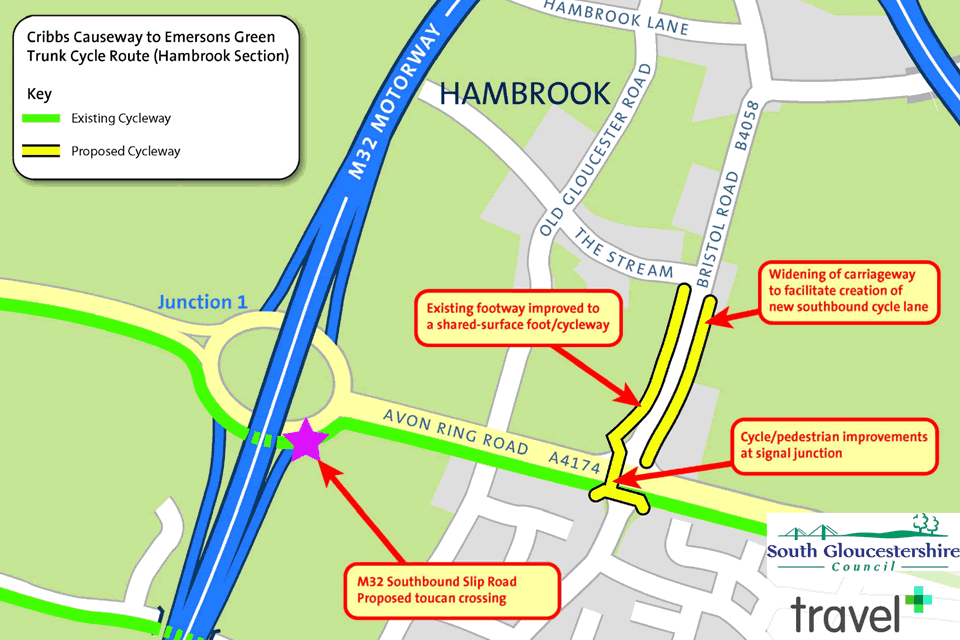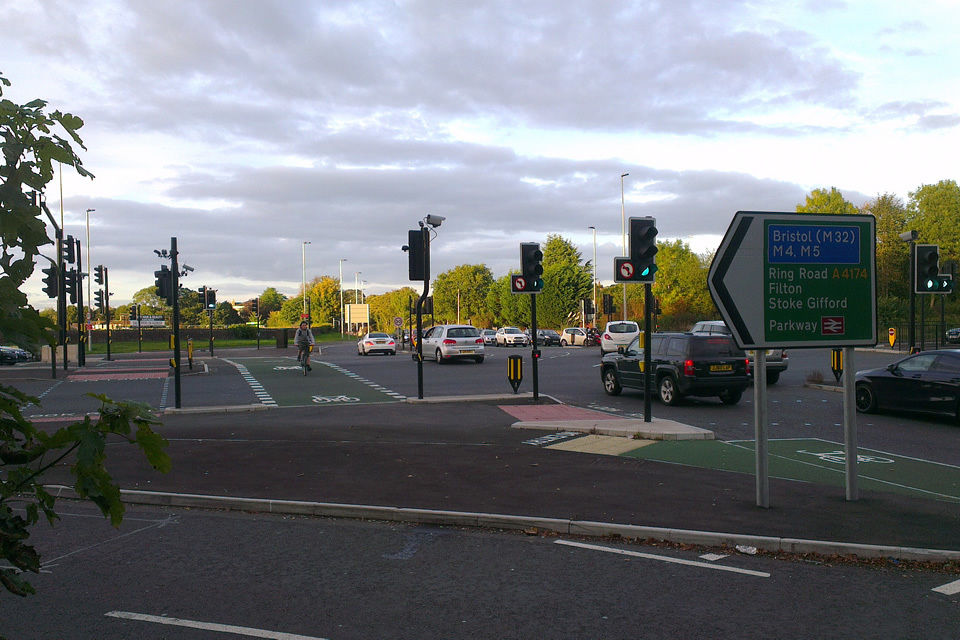Introducing a cycle crossing on the A4174
A signalled crossing for cyclists was built on the A4174 in order to make it easier for them to cross and to reduce delays.

Crossing of one of the Hambrook Junction slip roads.
What we did
South Gloucestershire Council introduced a ‘straight through’ signalled crossing for cycle traffic across the A4174, a major 6 lane highway. The crossing is separate from the pedestrian crossings and reduces delays for cyclists by allowing them to cross the ring road in a single phase.
Cycle traffic is detected by overhead microwave detection which places a demand in the signal controller, or cyclists can use a push button unit. The green signal for cyclists occurs at the same time as the green signal for Bristol Road northbound traffic from the south.

Overview of the scheme. Larger version and more scheme diagrams are available to download at end of page.
A combination of responsive traffic signal control using MOVA (Microprocessor Optimized Vehicle Activation) and lane widening has allowed shortened green times for A4174 movements, in turn allowing a greater allocation of time to cycles and pedestrians on all arms of the junction.
The heavy volumes of A4174 motor traffic previously resulted in little green time for cyclists to cross the uncontrolled side roads. The ring road path now also has signalled crossings across Bristol Road.
The overall scheme also included:
- widening of Bristol Road north of the Hambrook Junction to provide a shared surface footway and cycle track on its east side and a southbound on-carriageway cycle lane (£751,000)
- a Toucan crossing across the M32 southbound on-slip 500m to the west (£250,000)
- a temporary Toucan crossing of the A4174 150m west of the junction during the main construction works (£35,000)
The layout is ‘future proofed’ with carriageway widening to accommodate a bus lane for the proposed MetroBus scheme, avoiding future duplicate construction costs and delays.
Why we did it
The dual carriageway at Hambrook Junction north of Bristol has 3 lanes eastbound, and 2 lanes plus a bus lane westbound. It’s one of the busiest roads in South Gloucestershire, used by 53,000 vehicles per day (2014), of which 4% are heavy goods vehicles.
The difficulty of crossing the A4174 and the side roads at Hambrook Junction had been highlighted by users as a constraint to increasing use of this route.
The dedicated cycle crossing and associated traffic signal infrastructure allows cyclists to cross the A4174 in a single phase. This improves journey times through the junction and aims to encourage cycle use from the residential areas of the region to the employment zones and educational establishments.
By widening Bristol Road we were able to re-allocate traffic signal time throughout the junction, reducing signal cycle times, and to provide cycle crossings and pedestrian crossings.

Hambrook Junction showing the 'straight through' north-south ring road crossing.
How we did it
South Gloucestershire Council’s lead members for transport approved a proposal to make a bid to the central government Cycle Ambition Fund for a range of schemes across the region to improve movement of cyclists through known pinch points on the network, including this site.
The Planning, Transport and Strategic Environment Committee subsequently approved the detailed site designs for inclusion in the bid. Following the successful submission, the scheme at Hambrook Junction was included in the Council’s Local Transport Capital Programme.
By following this process councillors were fully involved in the scheme from conception to completion. Council officers gave briefings to political groups, public forums including the Cycle Forum and the Public Transport Forum, and user groups. We also engaged with the media to promote the advantages of the scheme and to warn the travelling public of the potential for disruption while the scheme was being built.
The project was managed and delivered internally by South Gloucestershire’s ‘StreetCare’ team. This ensured close and effective working relations between project managers, designers, engineers and construction staff. This was especially important because of the tight time constraints and limited opportunities (the school holidays) for temporary traffic management and lane closures to enable the works to take place.
We agreed temporary diversion routes for cyclists and pedestrians with user groups and put them in place before the construction works started. As a result we were able to implement a more efficient traffic management layout for through traffic and reduce the potential for conflict between cyclists and motorists.
The Department for Transport authorised, on a scheme specific basis, the use of non-standard ‘Elephants Footprint’ markings to delineate the cycle crossing and far side red / amber / green cycle symbols. It’s expected that these specific authorisations will not be necessary with the 2016 version of Traffic Signs Regulations and General Directions.
Frenchay Hospital, 750 metres from the junction, closed in the middle of the construction activity. Construction work was suspended while patients were moved to a new hospital. This was done in full consultation with the North Bristol NHS Trust and the construction team, and added no cost to the scheme. It demonstrates the positive relationship we were able to maintain with our community during a major project. It also shows the benefit of procurement through the StreetCare team, and the advantages of maintaining good relationships with our supply chain partners.
What we learned
By working with council members and key stakeholders in advance of the funding bid we were able to articulate the scheme’s benefits and in turn avoid challenge at key stages. As a result we had a group of champions in the community throughout construction.
We learned that there are advantages of minimising disruption and reducing overall spend by undertaking comprehensive improvements to the junction at one time (eg bringing forward the Metrobus work). This resulted from combining aspects such as temporary works and traffic management costs.
By negotiating with an adjacent private landowner and subsequently setting up a temporary compound as close as possible to the site, we were able to significantly reduce the movements of construction plant and materials. This reduced the overall programme and disruption to the travelling public.
Although the diversion of public utilities in advance shortened the construction programme, a lack of progress by the utility companies delayed the scheme. In future major works programmes we will discuss this with the utility companies to see if such occurrences can be minimised or avoided.
Further information
For more information email Tony.Sharp@southglos.gov.uk.